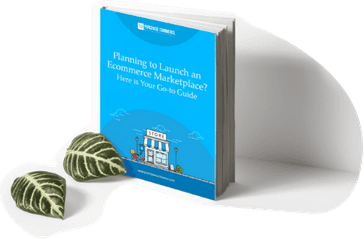According to the recent survey report, the growth of an online business is significantly faster and higher as compared to traditional businesses.
To establish your ecommerce business successfully, choosing the best online marketplace software plays a major role. It creates a good reputation for your brand and also helps you to expand your business worldwide.
In this article, let’s take a look into the 10 steps to build a full-fledged visually appealing online store with all the required ecommerce marketplace features in just 5 days, without any technical skills or expertise.
1. Purchase a domain name
Choosing and purchasing a domain name for any ecommerce business is an important part of designing your website because it should reflect the brand name of your business. The domain name of your multi-vendor marketplace website is the initial part of your brand, which the user will experience it and reserve a place for your ecommerce business in their mind.
2. Choose the best Multi-vendor Ecommerce platform with web hosting
To save the time and cost of your ecommerce website development, you can select a readymade ecommerce platform like Purchase Commerce, Shopify, etc. With these ready software, you can easily integrate plugins, payment gateway, and other functionalities.
Ecommerce website hosting is another factor that is crucial to the success of your business. If an ecommerce web hosting is bad, it can even affect your chance of securing your sale.
3. Choose a theme that suits your ecommerce website
To reduce your development time and cost, you can buy a readymade theme from your Online Store builder which resembles your brand and business vertical. For example, ThemeForest has plenty of ecommerce website templates that focus on a particular industry. Instead of building your ecommerce marketplace from scratch, a readymade template can make the task easier. By experience, the customization process will take time and money. So, if you find a readymade theme for your ecommerce platform, you'll likely save yourself from a headache.
4. Take your shopping cart website live
As soon as you start developing your ecommerce shopping cart website, take your ecommerce website to live, even before listing any of your product. Have your ecommerce website created with a Homepage, about us page, contact US page that will be helpful for various reason:
5. Find a product to sell online
In this digital world, multiple ecommerce platforms are there in the industry which sells different variety of items. They are a certain website which sells only a particular field of products such as garments, travel plan, fashion items and etc. Also, there are some of the ecommerce sites that sell multiple items likes electronics items, household appliance, accessories, books, sports goods and so on. So, choose your product niche and business vertical carefully that align with your brand and domain name.
6. Make Decision on Your Vendor Business Model
As an ecommerce marketplace software owner, you have to look for a flexible vendor business model in the software as per your requirements. This allows you to invite an unlimited number of vendors and sell all of their products on a common storefront. Also, you can set up the subscription and commission fees for every vendor depending on the hierarchy.
7. Choose the Right Payment Gateway
In an online marketplace business, you need to integrate multiple payment options for your store as there are multiple sellers who sell products on a common storefront. An ecommerce store builder like PurchaseCommerce can set up payment gateway functionalities to your website automatically. Every customer should be able to make payment via debit card, credit card, online wallet, net banking, COD &, etc.,
8. Secure Your Ecommerce Website with SSL Certificate
For all the websites that transfer their data through online, they must ensure secure transaction through SSL (Secured Security Layer) certificate. This certificate will keep your website more secure and build trust among your customers allowing them to transact safely on your ecommerce website.
9. Market Your Growing Business
Once you complete building your online marketplace, you need to promote your products to boost traffic and drive sales. So, you'll need to plan marketing tactics to increase your website traffic.
Purchase Commerce helps you with marketing strategy by:
- Offering inbuilt SEO for every product.
- Offering free integration for MailChimp, Campaign Monitor, etc.
- Integrate your ecommerce platform with Facebook.
- Enable a one-click social sharing process for all your product.
- Offer them the option to create coupons or discount to repeat the customer.
- Include a blog to share engaging & relevant content, build trust and attract a new customer.
10. Measure your store’s performance
Track your ecommerce website performance with the right analytics solution. In addition to the business model reporting within your ecommerce platform dashboard, PurchaseCommerce integrates your store with Google Analytics so that you can get to know your website’s in-depth analytics. This will help you to monitor your ecommerce website and product page so that you can improve sales and boost revenue for your business.
Stay ahead in the ecommerce race
Choosing the best marketplace software helps you to manage your business competitively and to promote your brand and visible to the world.
Purchase Commerce offers excellent marketplace features with its multi-vendor ecommerce platform. It enables you to launch your online marketplace business efficiently. Try a free demo of PurchaseCommerce and start selling instantly!

